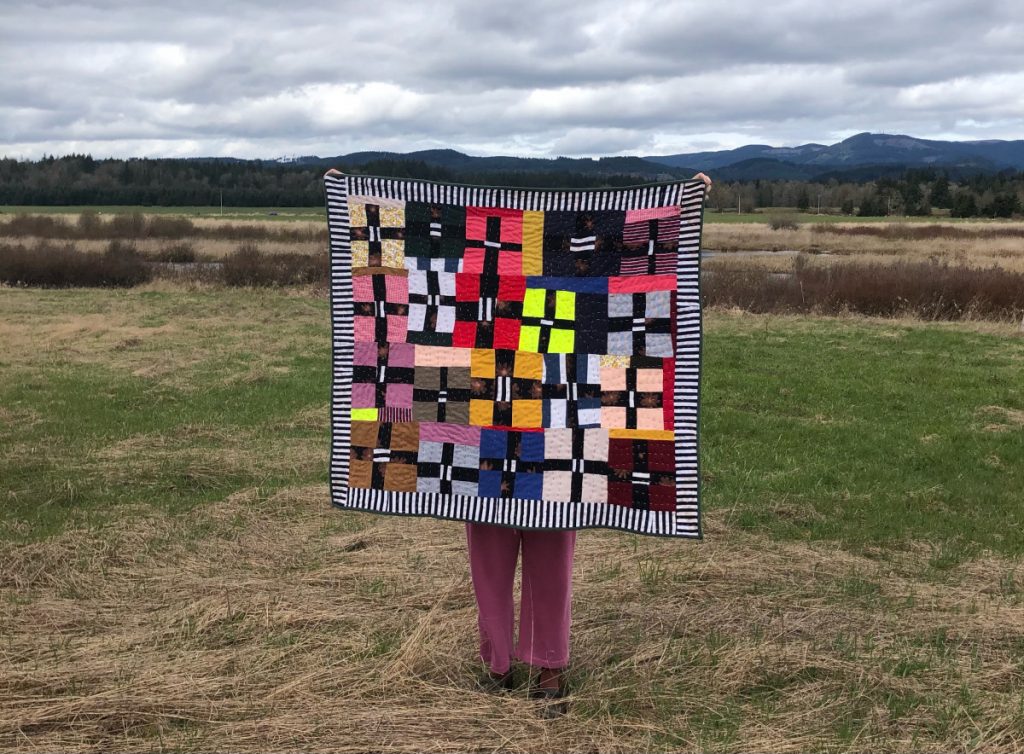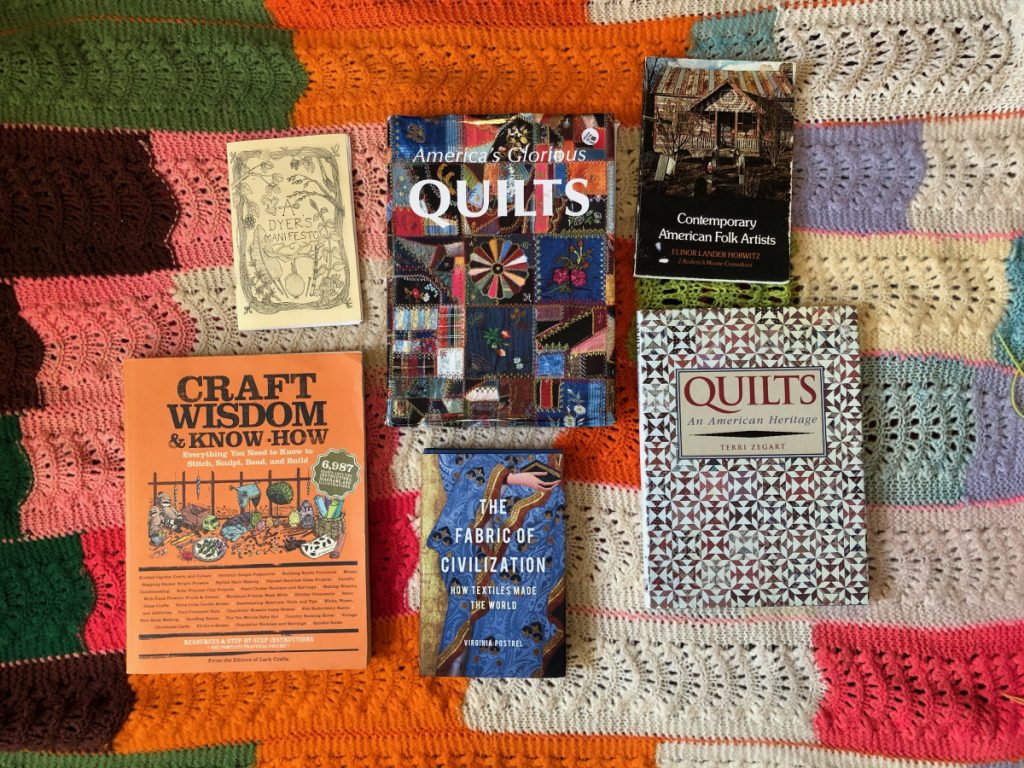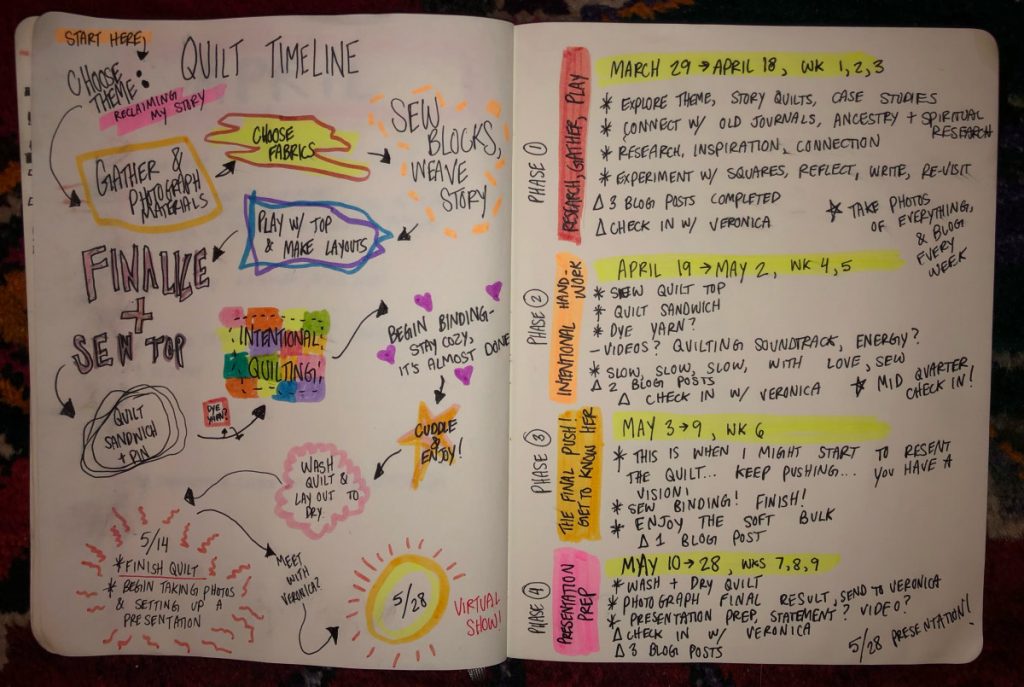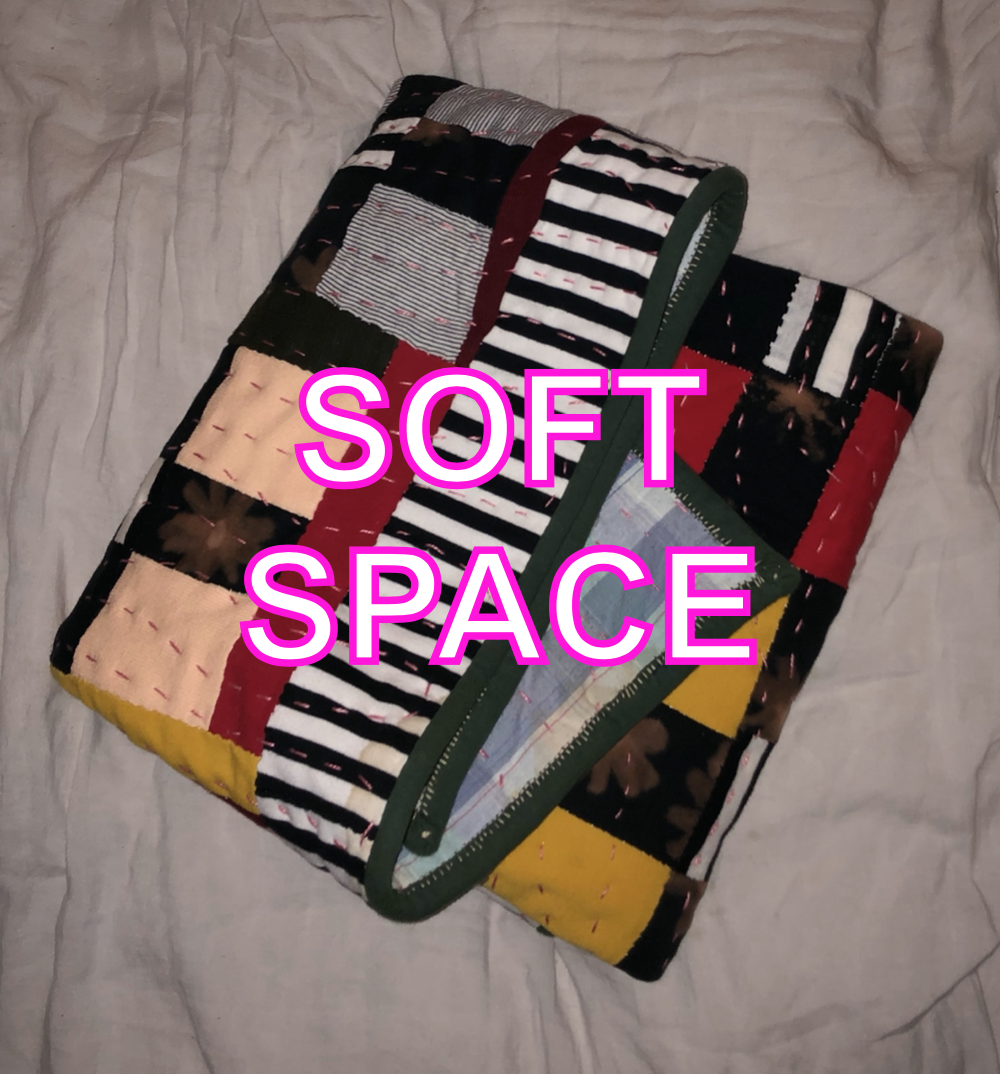1A: SUMMARY
During the break I tried to find ways to stay soft and tender towards myself and the changes I have undergone in the past few months. I spent entire days in bed attempting to rest and recover. But the actual practice of resting seemed impossible due to the guilt that comes with not using your time to produce money under the capitalist system. One of my goals this quarter is to try and break free from the idea that my time, my art, and my mental health all need to be focused on generating income. I am not quite there yet and I spent most of my time hand stitching a quilt, trying to improve my skills so I can make marketable products in the future.
My quilting project started out as a gift for a friend’s child, and over the course of the 10 weeks it took me to sew it, I formed a special bond with it. The energy put into the quilt was restless and stressed, with entire sections filled with triggering memories and pain. In the end, the quilt holds too much of my own past trauma to be given to a newborn. I decided to keep it and use it as the base for a soft and gentle space. A reminder that my past can have the power to hold and heal me, as I lay on top of it in the sun.

Complete (PC: Grace McLarty)
Above is the finished quilt. It doesn’t have a name quite yet, but when I look at it and hold it I am amazed. It still freaks me out that every single stitch was done by hand. Maybe I was on the edge of a mental breakdown but in the end all that energy was converted to this soft bulk.
During week one I focused on collecting my library for this quarter, designing the José Gómez Farmworker Justice Day website, and planning for the quilt I will make this spring. It was a chaotic week, but I am satisfied with all the work I got done.

Framing Texts (PC: Grace McLarty)
These are the books I hope to explore during this quarter. I will go into more detail in the following sections.
1B: RADICAL

Framing Texts (PC: Grace McLarty)
One of the books I am most excited to read this quarter is Radical Homemakers by Shannon Hayes.
“Radical Homemakers are men and women who have chosen to make family, community, social justice, and the health of the planet the governing principles of their lives. They reject any form of labor or the expenditure of any resource that does not honor these tenets. For about five thousand years, our culture has been hostage to a form of organization by domination that fails to honor our living systems, where ‘he who holds the gold makes the rules.’ By contrast, Radical Homemakers use life skills and relationships as a replacement for gold, on the premise that he or she who doesn’t need gold can change the rules. The greater our domestic skills, be thet to plant a garden, grow tomatoes on an apartment balcony, mend a shirt, repair and appliance, provide for our own entertainment, cook and preserve a local harvest or care for our children and loved ones, the less dependent we are on the gold.” pg 13, Radical Homemakers, Shannon Hayes
I have been highlighting this whole book like a crazy person because everything she says really resonates with me, but I am also starting to realize that this book was written by a white woman for white women. I am looking forward to finishing this book and gaining a basic understanding on the subject of radical homemaking and moving on to books and media by people who have different perspectives. I do believe Shannon Hayes is radical at heart, but some of the language she uses can be exclusive and I am also having trouble with her romanticising colonialism. She is currently writing a sequel to Radical Homemakers and I plan on reaching out to her via email this quarter to see if this new volume will address more social justice issues.
1C: HOME

Silvia Federici and George Monbiot are my inspiration in my exploration of economic alternatives to capitalism and the history behind domesticity, enclosure, the commons, and the nuclear family unit. Over the break, I listened to George Monbiot’s lecture at the Schumacher Center for New Economics while binding my quilt. I was so intrigued that I bought his book, Feral: Rewilding the Land, the Sea, and Human Life.
He talks about how kids who are brought up in green spaces do better than those who grow up surrounded by hard surfaces, such as concrete which I related to my interest in the softness of fiber art. He talks about how there is a lot of land in the UK is used solely for hunting grouse, which reminded me of our collective hunt last quarter for our own personal “grouse”. Perhaps Monbiot’s ideas surrounding land, ownership, and reclaiming the commons are my grouse.
1D: MAKING

Framing Texts (PC: Grace McLarty)
At the beginning of this quarter, I applied for the FPMTQSS Material Grant for Creators in hopes of getting essential supplies to create story quilt. The aim of the grant is to assist people in creating a piece of work that explores social justice issues, LGBTQIA, BIPOC, or disabled identities to be shown in a virtual showcase on 5/28/2021.

Material Grant Flyer (Photo Credit: FPMTQSS Facebook Page)
My application laid out a plan to create a quilt that attempts to tell my story. My past is something that I generally avoid looking at because of shame and pain, and because of that I don’t feel like I have a strong sense of identity, purpose, or confidence. By creating this quilt, I hope to weave together my painful history with addiction, sexual trauma, and abuse as well as explore my own sexuality and gender identity, my ancestry and heritage, and how I can use fiber arts and radical domestic work as a catalyst for creating a socially just and sustainable future for myself and my community.

Story Quilt Timeline (PC: Grace McLarty)
I am spending the first few weeks gathering materials and getting in touch with the theme I have chosen. I will be looking at lots of old journals and artwork and doing lots of experimenting. I also decided to make the switch from hand piecing the blocks together to using a sewing machine for the blocks and only doing the quilting by hand. I was against using a sewing machine for years, partially because I viewed it as cheating but mostly because I was scared that I wasn’t capable enough to learn how to use it. With the help of my little sister, I was able to learn how to use the machine and sew my first block in about 30 minutes. Does this make me a capitalist? Stay tuned.

Sewing Machine! (PC: Grace McLarty)
1E: ANNOTATED BIBLIOGRAPHY
Hayes, Shannon. Radical Homemakers: Reclaiming Domesticity from a Consumer Culture. Left to Write Press, 2010.
Schumacher Center for New Economics. (2020, October 25). Private Sufficiency, Public Luxury: Land is the Key to the Transformation of Society [Video]. Youtube. https://www.youtube.com/watch?v=63WSvrquIPU


Leave a Reply